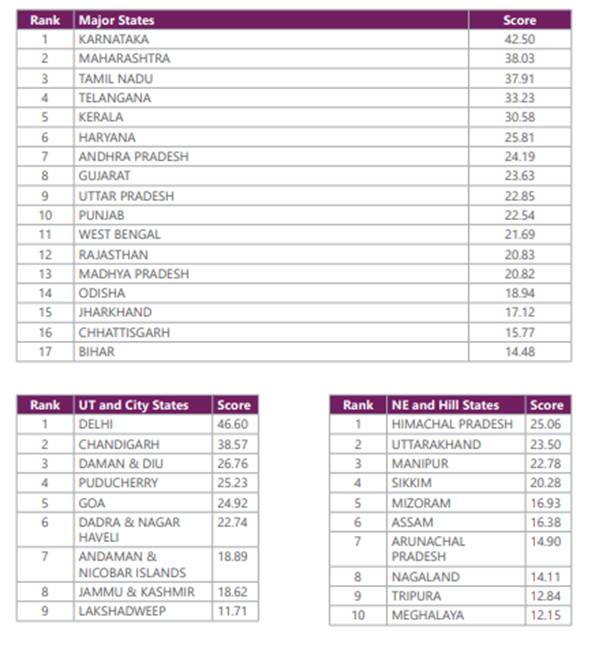India Innovation Index
India Innovation Index
NITI Aayog, along with the Institute for Competitiveness releases the India Innovation Index.
The first edition of the Index was launched in October, 2019.
About the Index
The India Innovation Index aims to create an extensive framework for the continual evaluation of India’s innovation environment. The index aims to rank states and UTs based on their scores, recognize opportunities and challenges, and assist in tailoring government policies to foster innovation.
NITI Aayog, with its mandate of promoting ‘competitive federalism’ among all states and union territories, is committed to utilize the India Innovation Index in catalysing the innovation outcome of the nation.
Third edition of III
The third edition of III was launched during July 2022. The third edition of the India Innovation Index 2021 too is set against the backdrop of the Covid-19 pandemic, which has disrupted the global socio-economic landscape.
The third edition highlights the scope of innovation analysis in the country by drawing on the framework of the Global Innovation Index. The number of indicators has increased from 36 (in the India Innovation Index 2020) to 66 (in the India Innovation Index 2021). The indicators are now distributed across 16 sub-pillars, which, in turn, form seven key pillars.
Karnataka, Manipur and Chandigarh have topped in their respective categories in the third edition of NITI Aayog’s India Innovation Index.
Among the 17 Major States, Karnataka, with a score of 18.01, is the top performer, followed by Telangana and Haryana. Chhattisgarh has scored the least, 10.97. And the average score for the Major States’ category is 14.02. Karnataka’s high score can be attributed to its peak performance in attracting FDI and a large number of venture capital deals. Karnataka also scores high in the ‘Performer’ dimension, with the highest share of ICT exports and GI registrations. Uttar Pradesh and Haryana have registered significant gains in promoting an innovative business environment with a large base of internet subscribers and a safe ecosystem for further investment in the region.
The North-Eastern and Hill States’ category comprises 10 states. The average score of this category is 14.41. Manipur with a score of 19.37 is at the top and Nagaland with a score of 11 is at the bottom. Manipur scored best in the knowledge workers and safety and legal environment pillars. Uttarakhand has the second highest score due to the state government’s high R&D investment. Uttarakhand also registered the highest expenditure on school education – 20.10% of its GSDP. Nagaland and Tripura scored the lowest due to their unutilised talent as indicated by their low performance in human capital and business environment, which indicates that their innovation capabilities have not been harnessed to their full potential.
Amongst the 9 Union Territories and City-States, the average innovation score is 15.74, higher than the national average. Chandigarh was the best performer, with a score of 27.88 and topped the overall rankings, followed by Delhi with a score of 27.00. Ladakh was at the bottom with a score of 5.91. Chandigarh topped the knowledge worker pillar while ensuring investment in school and higher education. Delhi has topped the business environment and investment pillars, with a large number of incubator centres, a skilled labour force and its continuously transforming start-up ecosystem. This has been reflected in their overall performance as well. Both performed higher in the ‘performers’ pillars. Ladakh and Lakshadweep occupy the last positions, with 5.91 and 7.86 scores, respectively. They have consistently performed low on all the pillars due to their geographical shortcomings and economic constraints, which require immediate attention to promote an innovative environment.
To access the complete report, click here.
Second edition of III
The report examines the innovation capabilities and performance of the states and union territories. The second edition of the index was launched in January, 2021.
In the second edition too, the index found that the level of competitiveness among the states and union territories was high, which is essential for them to continually improve on their enabling factors as well as innovation performance, year by year.
In the ‘Major States’ category, Karnataka continued to occupy the top position, while Maharashtra moved past Tamil Nadu to reach the second place. Telangana, Kerala, Haryana, Andhra Pradesh, Gujarat, Uttar Pradesh and Punjab completed the top ten in that order. Karnataka’s rank is attributable to its substantive number of venture capital deals, registered geographical indicators and information andcommunications technology exports. Karnataka’s high Foreign Direct Investment (FDI) inflow has also enhanced the innovation capabilities of the state. Four southern states—Karnataka, Tamil Nadu, Telangana and Kerala—occupied the top five spots under the ‘Major States’ category this year.
Overall, Delhi retained itsfirst rank, while Chandigarh made a big leap since 2019 and landed in the second place this year. Under the ‘North-Eastern/Hill States’ category, Himachal Pradesh moved up from the second position to emerge as the top ranker this year, while 2019’s top performer (in this category), Sikkim, slipped down to the fourth position.
The innovation inputs were measured through five enabler parameters, and the output through two performance parameters. While ‘Human Capital’, ‘Investment’, ‘Knowledge Workers’, ‘Business Environment’, ‘Safety and Legal Environment’were identified as enabler parameters, ‘Knowledge Output’ and ‘Knowledge Diffusion’were chosen as the performance parameters.

To access the complete report, click here.
Source : NITI Aayog
Last Modified : 7/24/2023
Provides information about SDG Urban Index and Das...
This topic provides information about Healthy Stat...
Provides information about NITI Aayog's white pape...
The asset monetisation pipeline of Central ministr...
